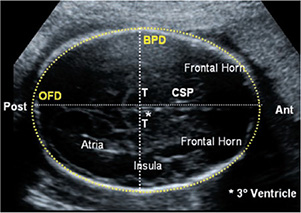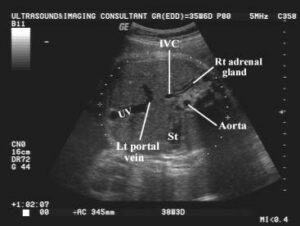What is a fetal pole?
The fetal pole is an early sign of embryonic development, typically visible on an ultrasound scan around 6-7 weeks into a pregnancy. It appears as a small, curved structure with a heartbeat and is important in determining the viability and health of the developing fetus.
The fetal pole forms from the embryonic disk, which is the inner layer of cells in the developing embryo. As the fetal pole develops, it begins to take on a recognizable shape and begins to develop important structures such as the brain, heart, and digestive system.
The presence of a fetal pole on an ultrasound is a reassuring sign that the pregnancy is progressing normally. However, the absence of a fetal pole can be an indication of a miscarriage or an ectopic pregnancy, and additional tests or monitoring may be necessary.
It’s important to note that the fetal pole is just one aspect of fetal development and that continued monitoring throughout pregnancy is necessary to ensure a healthy outcome.

Fetal Pole
Measurement of fetal pole.
The fetal pole is typically measured during an ultrasound exam, which is a non-invasive imaging test that uses sound waves to create images of the developing fetus. The measurement of the fetal pole is important in determining the gestational age and health of the developing fetus. The measurements can also be used to track fetal growth and development over time. Your healthcare provider will use these measurements, along with other diagnostic tests and exams, to monitor the progress of your pregnancy and ensure a healthy outcome
The fetal pole can be measured in a few different ways, including:-
Crown-Rump Length (CRL):- This measurement is taken from the top of the fetal head (crown) to the bottom of the fetal rump (buttocks). It is the most accurate way to estimate fetal age and is typically done between 6-12 weeks of pregnancy.

Biparietal Diameter (BPD):- This measurement is taken across the widest part of the fetal head and is used to estimate fetal age and growth. It is typically done after 13 weeks of pregnancy.

Abdominal Circumference (AC):- This measurement is taken around the fetal abdomen and is used to estimate fetal weight and growth. It is typically done after 20 weeks of pregnancy.

Function Fetal Pole.
The fetal pole is a crucial structure in the early development of a fetus. It serves several important functions, including:-
Confirmation of pregnancy:- The presence of a fetal pole on an ultrasound is a clear indication of pregnancy, confirming that a fertilized egg has implanted in the uterus.
Determination of gestational age:- The size of the fetal pole can be measured during an ultrasound and used to estimate the gestational age of the developing fetus.
Establishment of fetal viability:- The fetal pole is the first visible sign of a developing embryo, and the presence of a fetal heartbeat confirms the viability of the pregnancy.
Formation of key structures:- As the fetal pole develops, it begins to form key structures such as the brain, heart, and digestive system.
Prediction of pregnancy outcome:- The size and growth of the fetal pole can be used to predict the outcome of the pregnancy, with slower or abnormal growth potentially indicating a higher risk of pregnancy loss or other complications.
What does no fetal pole mean on an ultrasound?
If an ultrasound scan shows no fetal pole, it may indicate a miscarriage, an ectopic pregnancy, or an error in gestational age estimation. A fetal pole should be visible on an ultrasound scan by 6-7 weeks of pregnancy. If no fetal pole is seen at this time, it may suggest that the pregnancy is not developing as expected. However, in some cases, it may simply mean that the pregnancy is not as far along as originally estimated, and a follow-up ultrasound may be recommended to confirm the gestational age and assess the viability of the pregnancy.
If no fetal pole is seen at a later stage of pregnancy, it may indicate a missed miscarriage, which occurs when the pregnancy has ended but the body has not yet recognized it. In this case, further testing and follow-up with a healthcare provider is necessary to determine the best course of action, which may include a procedure to remove the remaining tissue from the uterus.
What does it mean if a fetal pole has no heartbeat?
If a fetal pole is visible on an ultrasound but no heartbeat is detected, it may indicate a non-viable pregnancy or a miscarriage. A fetal heartbeat is typically visible on an ultrasound by 6-7 weeks of pregnancy, so the absence of a heartbeat at this stage can be a cause for concern.
There are several reasons why a fetal pole may not have a heartbeat, including chromosomal abnormalities, developmental problems, or issues with the placenta. In some cases, the lack of a heartbeat may be due to an error in gestational age estimation, and a follow-up ultrasound may be recommended to confirm the age of the pregnancy and assess the viability of the fetus.
If a lack of fetal heartbeat is confirmed on a follow-up ultrasound, it may be an indication of a missed miscarriage or a non-viable pregnancy. In this case, further testing and follow-up with a healthcare provider is necessary to determine the best course of action, which may include a procedure to remove the remaining tissue from the uterus.
It’s important to note that the absence of a fetal heartbeat does not always mean that a pregnancy will not progress normally. However, any concerns about the health or progress of a pregnancy should be discussed with a healthcare provider.
Fetal Pole At 5 Weeks.
At 5 weeks of pregnancy, the fetal pole is usually visible on an ultrasound as a small, round structure measuring between 1-2 mm in length. The fetal pole is the first visible sign of a developing embryo and typically appears around the 5th week of pregnancy.
During this early stage of development, the fetal pole is still very small and basic, with only a few visible features such as the yolk sac, which provides essential nutrients to the developing embryo. The fetal pole is also surrounded by a fluid-filled gestational sac that protects and supports the developing embryo as it grows.
At 5 weeks of pregnancy, the fetal pole is still in the early stages of development and will undergo rapid growth and changes in the weeks to come. Regular ultrasounds may be recommended to monitor the growth and development of the fetal pole and ensure a healthy outcome for both the mother and the developing fetus.

Fetal Pole At 5 Weeks
Fetal Pole At 6 Weeks.
By 6 weeks of pregnancy, the fetal pole should have developed further and become more visible on an ultrasound scan. At this stage, the fetal pole should measure around 5-6 mm in length and have a visible heartbeat, which is a crucial sign of a healthy pregnancy.
The fetal pole should have also developed more distinct features, such as the head and body, as well as small arm and leg buds. The yolk sac, which provided essential nutrients to the developing embryo, should also be visible and decreasing in size as the placenta takes over this function.
The gestational sac surrounding the fetal pole should also be clearly visible on the ultrasound, and its size can be measured to confirm the gestational age of the pregnancy. The size of the gestational sac should correspond to the expected gestational age of the pregnancy, with a deviation in size potentially indicating a complication such as an ectopic pregnancy or a blighted ovum.

Fetal Pole At 7 Weeks.
By 7 weeks of pregnancy, the fetal pole should have grown significantly and developed even more distinct features, which should be clearly visible on an ultrasound scan. At this stage, the fetal pole should measure between 10-15 mm in length and have a well-defined head and body, as well as small arm and leg buds.
The heart rate of the fetus should also be clearly visible and measure between 120-160 beats per minute. This is a crucial sign of a healthy pregnancy and an important milestone in fetal development.
The yolk sac, which provided essential nutrients to the developing embryo, should continue to decrease in size as the placenta takes over this function. The gestational sac should also continue to grow and correspond to the expected gestational age of the pregnancy.
Fetal Pole At 8 Weeks.
By 8 weeks of pregnancy, the fetal pole should have developed even further and should be clearly visible on an ultrasound scan. At this stage, the fetal pole should measure between 16-22 mm in length and have well-defined features, including a distinct head and body, as well as arms and legs that are developing and beginning to take shape.
The heartbeat of the fetus should still be clearly visible and measure between 140-170 beats per minute. The yolk sac should be almost completely absorbed by this stage, and the placenta should have taken over the vital role of supplying nutrients to the developing fetus.
The gestational sac should continue to grow and correspond to the expected gestational age of the pregnancy. It should also be noted that by 8 weeks of pregnancy, the gestational sac should be visible outside of the uterus on an ultrasound scan, and the presence of an ectopic pregnancy should be ruled out.
Fetal Pole At 9 Weeks.
By 9 weeks of pregnancy, the fetal pole should have grown even more and developed further, with well-defined features that are clearly visible on an ultrasound scan. At this stage, the fetal pole should measure between 22-30 mm in length and have developed fingers and toes that are beginning to separate.
The heartbeat of the fetus should still be clearly visible and measure between 140-170 beats per minute. The placenta should be well-established and continuing to supply nutrients to the developing fetus.
The gestational sac should continue to grow and correspond to the expected gestational age of the pregnancy. The amniotic fluid, which surrounds and protects the fetus, should also be increasing in volume.
FAQs.
Q) What does a fetal pole indicate?
a fetal pole provides information about the embryo’s location, gestational age, possible complications and whether there’s more than one embryo.
Q) What is a fetal pole at 6 weeks?
A fetal pole at 6 weeks measuring 1-2 mm in length.
Q) How long is fetal pole by week?
The fetal pole grows at a rate of about 1 mm a day, starting at the 6th week of gestational age.
BOOK LINK:-https://amzn.to/3mBS4cy
Sonography Scanning: Principles and Protocols (Ultrasound Scanning)
BOOK LINK ;-https://amzn.to/3A1mJmH

